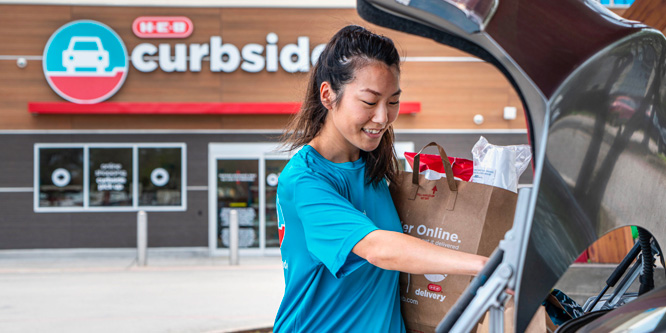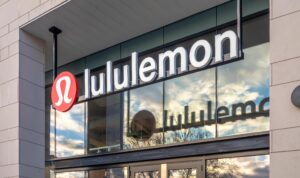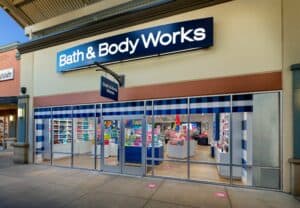
Photo: H-E-B
July 1, 2022
Is H-E-B’s e-grocery playbook a primer for taking on Amazon?
H-E-B is just oh so slightly better at online grocery than Amazon.com.
That’s the finding from the first annual “eCommerce Retailer Preference Index” (RPI) from dunnhumby.
Texas-based H-E-B snagged the top spot in the ranking based on “a consumer survey-informed statistical model that predicts how retailers execute on the customer needs that matter most” when it comes to building emotional bonds with customers that lead to higher, more profitable sales.
The margin of victory was narrow for H-E-B — close to a statistical tie with Amazon. Amazon Fresh was third on the list, followed by Walmart, Sam’s Club, Kroger, BJ’s and Sprouts.
“H-E-B’s impressive performance proves that it’s possible to compete and win against Amazon when it comes to grocery e-commerce. Their success offers mid-size and regional retailers a roadmap on how to succeed online,” Grant Steadman, president of North America for dunnhumby, said in a statement. “H-E-B’s eCommerce journey goes back to 2015, when they first started with curbside pickup, and they have since built up a powerful online ecosystem. The combination of a simple and easy-to-use shopping experience with a fantastic emotional connection with customers shows how grocers can thrive in this multichannel landscape.”
Dunnhumby is not the only firm that has sought to identify the best online grocer in the business.
Chicory’s “2022 Online Grocery Usership” survey placed Walmart at the top and Amazon second as customers’ source for online groceries, according to a report from the Private Label Manufacturers Association (PLMA). Instacart placed third in that survey, followed by Target, Kroger, Albertsons, Stop & Shop and Shipt. The survey also found that Walmart is growing more popular with Gen X shoppers.
The findings, with regard to Amazon, are more consistent with what dunnhumby reported in its “2021 Retailer Preference Index,” a study that tracks the entire grocery channel and is separate from the recently released e-commerce study. The 2021 RPI found that Amazon had outperformed both H-E-B and Trader Joe’s in terms of customer preference. Walmart lagged far behind in that survey, coming in fourteenth place. The 2021 RPI attributed Amazon’s positive performance to its speed and momentum in managing the novel coronavirus pandemic.
While its only U.S. locations are in Texas, H-E-B is the fifth-largest grocery operator in the country. In addition to its grocery stores, it also owns and operates a number of restaurants, food-to-go dining concepts and healthcare clinics.
- H-E-B Edges out Amazon as the Top U.S. eCommerce Grocery Retailer, dunnhumby Retailer Preference Index Finds – dunnhumby
- Walmart Winning Over Gen X for Online Grocery – Private Label Manufacturers Association
- Covid-19 Propels Amazon to Top U.S. Grocery Retailer for the 2021 dunnhumby Retailer Preference Index – Business Wire
- H-E-B is right at home with its new shop-in-shop concept – RetailWire
Discussion Questions
DISCUSSION QUESTIONS: What characteristics set apart the top players in e-grocery? Does H-E-B’s success hold lessons for other online grocers?
Poll
BrainTrust
Paula Rosenblum
Co-founder, RSR Research
Richard Hernandez
Merchant Director
Gary Sankary
Retail Industry Strategy, Esri
Recent Discussions







The rank of players depends on the metrics you use. In terms of efficiency, speed, accuracy and so forth, Amazon is certainly up there. When it comes to profitability, range of compelling own-labels, ability to collect from physical stores, and so forth – Amazon likely isn’t so good as some of the traditional players, especially ones like H-E-B which has an excellent track record in areas like range innovation and customer service. The bottom line here is that e-commerce in grocery is extremely difficult and profitability is often elusive: Amazon will find it more difficult to win here than it has in other categories.
Seems to me that the common thread here is early investments in processes and technology. So by definition, everyone else is late to the game. I think H-E-B also gets extra brand loyalty because it was already beloved. It has also been early adopters of new tech for as long as I’ve been an analyst.
I also think a solid in-stock position is very important. I know that a couple of specific grocers missing from the top 10 have consistent out of stock problems. First I thought the differentiator was “do it yourself without Instacart,” but Sprouts is using Instacart, at least here in South Florida. So once you start asking a paid for shopper (regardless who they work for) to pick substitutes, they may try hard, but they can’t know what you want, and while they try hard and send photos, etc. you have to be sitting by your computer screen to respond, which partly defeats the purpose of the whole exercise. Or, to use the word of the week, it creates “friction.”
The lesson is straightforward: get your processes and technology in order. Doesn’t hurt to get your personnel in order as well.
There is no instant magic bullet in retail, especially in the grocery business. H-E-B started early and often with great customer experience and experimentation in technology to enhance it. A technology-centric approach has the advantage of being able to deliver features quickly, but positive loyalty and perception is a long game.
H-E-B has always been a company that plans, tests and is constantly modifying and reviewing its processes and services and it is no surprise that they are once again at the top of another facet of grocery retail. H-E-B has a loyal customer base and that starts with exceptional person-to-person customer service. While we know (and H-E-B knows) that Amazon is the big elephant in the room, H-E-B always finds a way to differentiate and make the experience more enjoyable.
I’m a bit skeptical of the lists and metrics cited in this piece. H-E-B is beloved in Texas and has been for a long time. They know their customers and deliver an outstanding experience across all channels. I believe their ranking on this survey reflects their overall strength in customer engagement and execution. They have done an excellent job using technology to extend that brand experience, where it makes sense, and are being rewarded for it.
Every retailer’s brand proposition is different. For H-E-B, its outstanding service and high-quality products. For others, it’s frictionless shopping or low prices. Every successful retailer today understands how their customer perceives them and what differentiates them from others in their segment. Leveraging that differentiation is how they compete successfully. Technology typically doesn’t create the advantage. It only enables them to amplify the things that they already do well.
I haven’t read these surveys, but I assume H-E-B inched out Amazon by basing their technological models of consumer survey data. Put another way, H-E-B does what it has for as long as I’ve followed it, put the consumer in the driver’s seat and follow their lead. In terms of being a model, anyone can clone technology. Technology alone isn’t a competitive advantage, at least for very long. But few retailers study their customer base as thoroughly or with the same nuanced sophistication H-E-B has brought to the table for decades. Can other grocers learn from them? Of course. Will they? That’s another question entirely.
Could it be that being a highly successful retailer outside of online increases one’s chance of success online? Or more likely, how could it not?
Matt offered precious few details of their playbook, so it’s hard to say what if any applicability it has to others. My recommendation to anyone would be to study all successful retailers, but don’t expect to (blindly) copy any of them.
H-E-B being a customer-centric retailer builds backwards from their shoppers to fit their business, their values, their way of integrating service, rather than only bolting on an eComm solution. This approach and success should give every other grocer and retailer motivation and usable ideas to be effective while holding marketshare against Amazon.
Building in mind with own brand, core values, and being intentional about every step of the intended CX (customer experience), grocers can compete with Amazon.
The H-E-B playbook is simple: find out what customers want, give it to them and get it right the first time. No doubt its customer delight mantle acts as a “halo” for its online operations. The key is customer intimacy, employing technology to support a customer delight strategy.